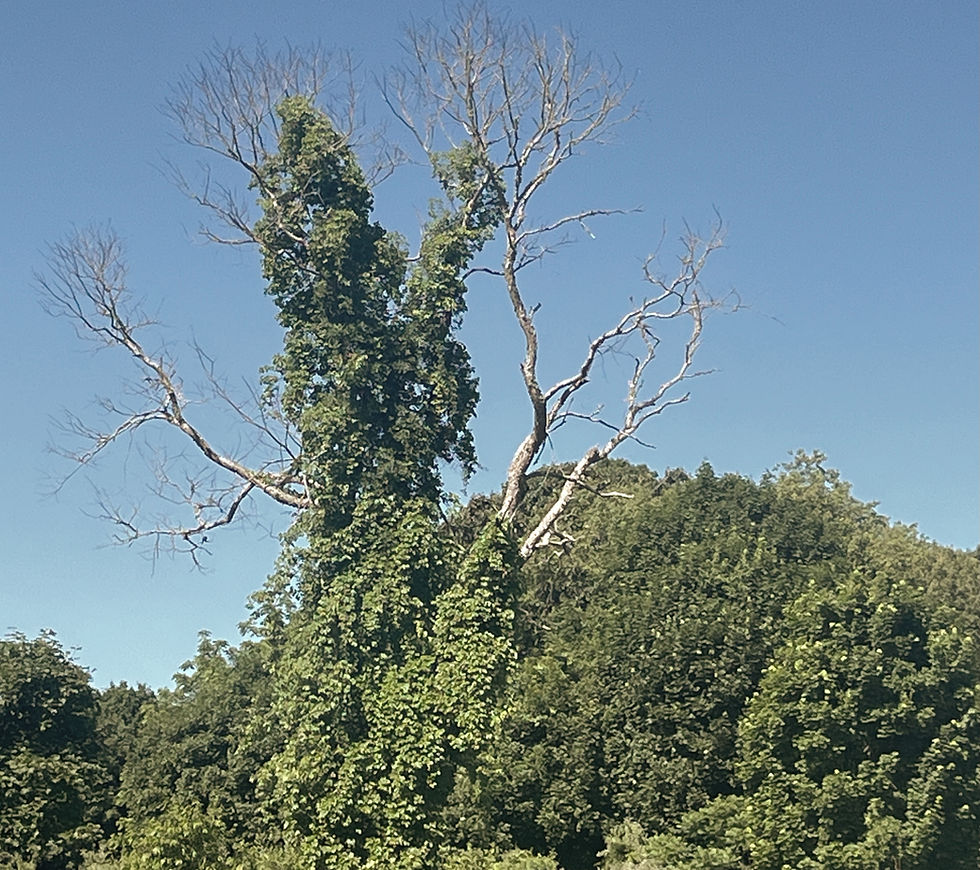Fostering Tree Health and Ivy Impact
- Dayzane Desouza
- Jun 12, 2024
- 3 min read
Most home owners don't realize how Ivy can be detrimental for their trees. In most cases, during our in person tree consultation their perspective is always "but it looks so pretty!"
So we decided to share this blog post to give our clients some insights about the importance in noticing what can be bad for our trees, when it's necessary to come in and remove Ivy so trees can thrive. It's important to understand that in the forest, everything can coexist due to the fact that raw Nature does not create an unsafe environment, everything is perfect and beautiful exactly how God has created it. But when we take into consideration all the damage our trees and plants get from ivy, insects, fungus and so on, it's easier to start paying attention to what we need to let go of. So here is the approach on Ivy and how it may affect trees in general.
Ivy (Hedera helix) is a common sight in many forests, gardens, and landscapes, often admired for its lush, green appearance and ability to cover surfaces. However, its impact on trees and their health is a subject of considerable debate among botanists, arborists, and ecologists. Ivy's growth habit allows it to climb and spread over trees, creating a dense canopy that can be both beneficial and detrimental to the host tree. One of the primary concerns is that ivy can compete with trees for sunlight, water, and nutrients.
As it climbs, ivy forms a thick blanket of foliage that can overshadow the tree's own leaves, reducing photosynthesis. This diminished light access can weaken the tree over time, making it less vigorous and more susceptible to disease and pests. Additionally, ivy's roots can compete with the tree's roots for water and nutrients, further stressing the tree, especially in environments where these resources are limited.
Another significant impact of ivy on trees is its potential to cause physical damage. The weight of mature ivy can be substantial, particularly after rain when the leaves and stems are saturated. This added weight can cause mechanical stress, leading to branch breakage or even toppling of smaller or already weakened trees. Therefore, ivy can exacerbate structural problems in trees, such as those caused by decay or poor branching habits.
As ivy grows, it can infiltrate cracks and crevices in the tree's bark, potentially widening them and allowing pathogens to enter. The dense cover of ivy also creates a microenvironment that retains moisture, which can promote fungal growth and increase the likelihood of infections.
However, not all interactions between ivy and trees are negative. Ivy can provide several ecological benefits. For instance, it offers habitat and food for various wildlife species. Birds, insects, and small mammals often use ivy for nesting, shelter, and forage. Ivy flowers are a valuable nectar source for pollinators, particularly bees, during late autumn when few other plants are in bloom. Its berries, though toxic to humans, are an important winter food source for birds.
In urban environments, ivy-covered trees can contribute to green infrastructure, helping to cool the air, reduce pollution, and provide aesthetic value.
The impact of ivy on trees can also vary depending on the species of tree and the environmental context. Some trees, particularly robust, mature specimens, can coexist with ivy without significant detriment. In contrast, younger, smaller, or already stressed trees might be more adversely affected.
The climate and soil conditions also play a role; in some areas, ivy may grow more aggressively, exacerbating its competitive effects. In less favorable conditions, its growth might be more controlled and less impactful.
Effective management of ivy on trees requires a nuanced approach. In some cases, removing ivy might be necessary to protect vulnerable trees, particularly in conservation areas or where high-value trees are at risk. This can be done by cutting the ivy at the base and allowing it to die back naturally, avoiding the need for herbicides that could harm the tree or surrounding flora. In other situations, allowing ivy to grow might be acceptable or even desirable, particularly where it provides significant ecological or aesthetic benefits.
Balancing these considerations requires a thorough understanding of the specific context and the health and needs of the individual trees involved. Ivy's impact on trees is complex and multifaceted. While it can compete for resources, cause physical damage, and promote disease, it also provides important ecological benefits and can coexist with trees under the right conditions.
Understanding and managing ivy's growth on trees is essential to maintaining healthy, resilient tree populations and maximizing the benefits of this ubiquitous plant. Effective management strategies should consider the specific environmental context, the species and health of the trees involved, and the broader ecological impacts, striving for a balance that supports both tree health and biodiversity.
Do you have a tree that's suffering from the impact of invasive Ivy?
Contact us now and we can figure out what the best solution is.







Comentarios